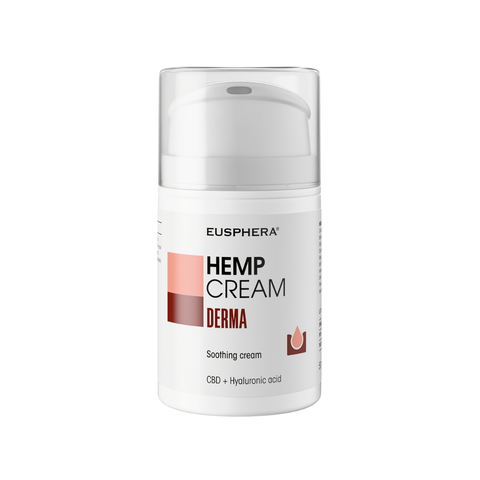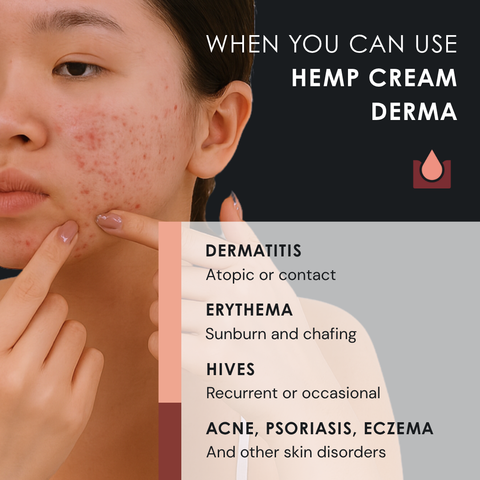If you’re reading this article, you’re probably looking for a better understanding of the responsible use of cannabis for therapeutic purposes.
More and more people are turning to CBD as a natural solution for managing conditions such as prolonged stress, anxiety symptoms, muscle pain or inflammation. However, it's crucial to understand that not all cannabinoids are the same: some compounds, such as CBD, have therapeutic properties without psychoactive effects, while others, such as THC, can alter mental state and perception.
One of the most well-known cannabinoids is THC, short for tetrahydrocannabinol, the psychoactive compound responsible for the “high” commonly associated with cannabis.
This article provides a clear, science-based overview of CBD and THC, explaining what they are, how they work, and how they differ.
What Is THC and where is it found?
THC, or tetrahydrocannabinol (full name: delta-9-tetrahydrocannabinol or Δ9-THC), is the main psychoactive compound found in cannabis plants. Its chemical formula is C₂₁H₃₀O₂ – composed of 21 carbon, 30 hydrogen and 2 oxygen atoms arranged in a unique molecular structure.
This structure acts directly on the central nervous system, binding to cannabinoid receptors in the brain and triggering effects such as euphoria, altered perception of time and space, and increased appetite.
THC exists in several isomeric forms (same formula, different atom arrangement), but the best-known and most commonly referenced is (−)-trans-Δ9-THC, which can also be produced synthetically, and is known pharmaceutically as dronabinol.
In medicine, THC has been explored for its potential in treating chronic pain, chemotherapy-induced nausea and vomiting, and reducing intraocular pressure in glaucoma.
There are also semi-synthetic derivatives of THC, such as nabilone, the first cannabinoid approved for therapeutic use by the FDA.
Importantly, CBD is also an isomer of THC, but with a very different pharmacological profile and no psychoactive effects.
Because of its mind-altering potential, THC use is tightly regulated in many countries, due to risks such as anxiety, paranoia and dependency.
What is hashish?
Hashish is a concentrated form of cannabis and one of the most common ways THC is consumed. Understanding its form and effects helps clarify how THC is extracted and used, also outside of medical settings.
Hashish is a psychoactive substance made by compressing trichomes, the tiny resin glands on cannabis leaves and flowers, rich in cannabinoids. Its composition includes over 120 compounds, mainly THC and CBD.
Its effects vary by individual but generally include euphoria, relaxation, altered perception and reduced concentration. Negative effects may include anxiety, paranoia and dependency.
The production method involves collecting trichomes and pressing them into solid blocks, ranging in colour from green to dark brown depending on the strain and method.
Hashish is illegal in many countries, including Italy, due to health concerns.
Benefits and risks of THC
Let’s take a look at the potential benefits that cannabinoids – especially THC and CBD – may have when used therapeutically:
• Pain relief: both compounds are used to treat chronic pain by modulating pain perception and reducing inflammation.
• Anti-nausea: effective in managing nausea and vomiting, particularly during chemotherapy.
• Support for anxiety, stress and sleep: therapeutic cannabis compounds help calm the nervous system, easing mental agitation and improving sleep quality.
THC is used under medical supervision in cases such as:
• Chemotherapy-related pain and nausea
• Enhancing antispasmodic drug effects (e.g. in IBS)
• Supporting glaucoma treatment by lowering intraocular pressure
However, THC use also comes with risks:
• Short-term: may cause anxiety, paranoia, temporary cognitive impairment and memory issues
• Long-term (especially with early or frequent use): increased risk of dependency, psychiatric disorders (e.g. depression or psychosis) and reduced cognitive function
THC must always be prescribed and monitored by a healthcare provider, balancing benefits and risks.
Why does THC get you "high"?
THC is the main psychoactive compound in cannabis. The “high” occurs because THC interacts with the endocannabinoid system. Specifically:
• CB1 receptors – found mainly in the brain and CNS, regulating pain, mood, memory and appetite
• CB2 receptors – mostly in the immune system, involved in inflammation and immune response
THC has high affinity for CB1, acting as a partial agonist, altering neuronal communication and triggering effects such as euphoria, relaxation and sensory distortion.
However, it can also cause anxiety, paranoia and disorientation. The intensity of the “high” depends on factors such as dosage, individual tolerance and mental/physical condition.
Effects occur quickly after use and may last several hours.
Frequent or long-term use may lead to dependency and mental health issues, so responsible use is essential.
Some cannabis strains are designed to minimise psychoactive effects, and contain very low THC.
CBD vs THC: characteristics and differences
THC and CBD are the two main cannabinoids in cannabis. Despite their shared origin, they have very different properties, effects and safety profiles.
Let’s compare their biological action:
• THC binds directly to CB1 receptors in the CNS, causing psychoactive effects – the typical cannabis “high”.
• CBD, in contrast, does not bind directly to CB1. It works more indirectly, modulating:
- natural endocannabinoids in the body
- serotonin and GABA pathways
- anxiety and stress regulation, and mood improvement
Main differences in their therapeutic use:
• THC requires strict control, precise dosing, and is used only in medical contexts due to its neurological impact
• CBD has high tolerability and is used in a wide range of treatments, without psychoactive risk
Both have valuable therapeutic potential, but their effects and safety determine how they’re used. Understanding the difference helps in making informed choices.
How long does THC stay in the human body?
THC can remain in the body long after its psychoactive effects wear off. Duration depends on:
- Frequency and amount of use
- Metabolism
- Body fat percentage
- Method of intake (smoking, edibles, etc.)
Once absorbed, THC binds to fat tissue, and is released slowly. This is why it can be detected days or weeks after use.
Saliva, blood and urine tests each have different detection windows.
THC in saliva, blood and urine: how long does it last?
• Saliva: detectable within minutes of consumption and for up to 6–8 hours (or up to 24 in regular users). New roadside saliva tests target recent use.
• Blood: short presence – 12–24 hours for occasional use; 2–7 days in regular users. Some metabolites persist longer.
• Urine: longest window – 3–4 days for occasional users; 10–30 days or more for chronic use. THC metabolites accumulate in fat and are released slowly.
Drug tests and driving
THC lingers even after its effects wear off, and this has legal and safety implications, especially for driving.
Drug tests don’t measure impairment, only presence. This means penalties are possible even hours or days after use.
Saliva testing, now used in roadside checks, makes it essential to know how long THC remains detectable – especially for those using cannabis therapeutically. Always consult your doctor and the legal regulations in force.
Legal status of THC in Italy and worldwide
THC laws vary widely across countries. Some (e.g. Canada, Uruguay, as well as parts of the USA) allow medical and recreational use. Others enforce strict bans.
In Europe, medical cannabis use is increasingly accepted, but national laws differ. In Italy, THC is legal only in specific, controlled forms.
Italian and European laws
• Italian Law no. 242 (2016) regulates industrial hemp (THC ≤ 0.2%, tolerance up to 0.6% for authorised crops). The limit applies to non-recreational products (e.g. oils, flowers).
• EU rules generally allow 0.2% THC, though countries like France and Germany are moving towards more flexible policies.
All hemp-based products must comply with strict traceability and labelling rules.
2025 legal updates
In 2025, cannabis regulation has sparked renewed debate in Italy, following updates to the Italian Highway Code. New legislative proposals aim for a clearer distinction between medical and recreational use, and to regulate low-THC products more clearly.
Despite EU progress, Italy remains cautious. The Ministry of Health confirms that medical cannabis will continue to be prescribed in controlled doses, while commercial and industrial products face stricter scrutiny.
Staying informed on evolving regulations is crucial for both consumers and producers.
Eusphera’s legal THC products
Wondering how to use CBD or THC safely?
Eusphera’s legal THC formulations do not produce a high, and are 100% legal (THC ≤ 0.2%). They are designed to naturally support health without psychoactive effects.
Examples include:
• EU4DOL PLUS – natural supplement for joint and bone health, useful for arthritis and muscle tension
• HEMP EXTRACT 20% – helpful for anxiety, panic attacks and depression
Thanks to advanced extraction technologies, pure CBD isolates with zero THC are now available. Our hemp is grown from EU-authorised varieties and processed in Italy in accordance with certified quality standards (HACCP, ISO, GMP).
For advice on usage or product details, feel free to contact our team.
Note: Always consult a medical professional regarding interactions between cannabinoids and existing treatments. Hemp products are not a substitute for medical therapy; they are natural allies for wellbeing.
THC FAQ:
Q: What’s the difference between cannabis, CBD and THC?
A: THC (psychoactive) and CBD (non-psychoactive) are cannabinoids from the cannabis plant. Their effects and uses differ.
Q: Where is THC found?
A: Mainly in the flowers and resinous trichomes of the cannabis plant.
Q: What is cannabis?
A: A plant used for medical, recreational and industrial purposes, containing active substances such as THC and CBD.
Q: What’s the active ingredient in marijuana?
A: THC – the psychoactive component. Marijuana also contains CBD, which has relaxing and therapeutic properties.
Q: How much THC is there in hashish?
A: It varies, but usually more than in raw cannabis, depending on the strain and production method.
Q: How does THC affect motor function?
A: It alters space-time perception and can impair coordination via CB1 receptor activity in the brain.
Q: What effect does THC have on the blood?
A: It can affect heart rate and blood pressure, and remain detectable in blood for hours or days.
Q: What are the effects of THC on the nervous system?
A: It releases dopamine, affecting mood, memory, perception, and cognitive function.
Q: What are the risks of cannabis containing THC?
A: Dry mouth, altered appetite, memory issues, paranoia, fatigue and possible dependency.
Q: How does THC differ from other cannabinoids?
A: Unlike other cannabinoids (e.g. CBD, CBN), THC is psychoactive and alters perception and cognition.
Q: Is cannabis with low THC legal?
A: It depends on local law. In many places, ≤ 0.2–0.3% THC is legal. Always check local regulations.
Q: Can THC in medical cannabis be harmful?
A: When properly prescribed, it’s safe, but side effects and long-term risks must be assessed by a doctor.
Q: Does THC have therapeutic properties?
A: Yes – for nausea, appetite loss, pain, muscle spasms and conditions such as MS or Tourette's.














